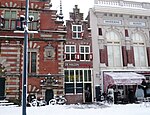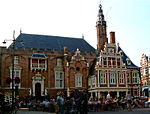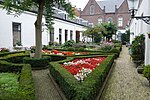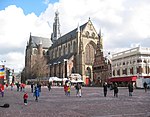Grote Markt (Haarlem)
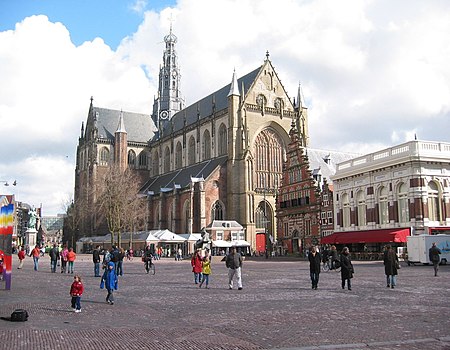
The Grote Markt is the central market square of Haarlem, Netherlands. According to the 1911 Encyclopædia Britannica; In the great market place in the centre of the city are gathered together the larger number of the most interesting buildings, including the quaint old Fleshers' Hall, built by Lieven de Key in 1603, and now containing the archives; the town hall; the old Stadsdoelen, where the burgesses met in arms; the Groote Kerk, or Great Church; and the statue erected in 1856 to Laurens Janszoon Koster, the printer. The Great Church, dedicated to St Bavo, with a lofty tower (255 ft.), is one of the most famous in Holland, and dates from the end of the 15th and the beginning of the 16th centuries. Its great length (460 ft.) and the height and steepness of its vaulted cedar-wood roof (1538) are very impressive. ... In the belfry are the damiaatjes, small bells presented to the town, according to tradition, by William I, Count of Holland (d. 1222), the crusader. The town hall was originally a palace of the counts of Holland, begun in the 12th century, and some old 13th-century beams still remain; but the building was remodelled in the beginning of the 17th century. It contains a collection of antiquities (including some beautiful goblets) and a picture gallery which, though small, is celebrated for its fine collection of paintings by Frans Hals.
Excerpt from the Wikipedia article Grote Markt (Haarlem) (License: CC BY-SA 3.0, Authors, Images).Grote Markt (Haarlem)
Grote Markt, Haarlem
Geographical coordinates (GPS) Address External links Nearby Places Show on map
Geographical coordinates (GPS)
| Latitude | Longitude |
|---|---|
| N 52.381366666667 ° | E 4.6359055555556 ° |
Address
Grote Markt
Grote Markt
Haarlem (Haarlem)
North Holland, Netherlands
Open on Google Maps

